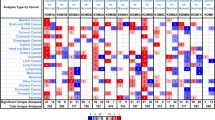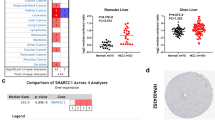Abstract
Hepatocellular carcinoma (HCC) is one of the most commonly diagnosed malignancy globally with a pessimistic prognosis. Previous studies have demonstrated that abnormal expression of genes in the lysine-specific histone demethylase 3 (KDM3) family with epigenetic changes and dysregulation of enzymes promotes cancer progression. In this study, multiomics analyses were utilized to analyze differential expression, prognostic value, genetic alteration, protein–protein interaction, associated biological pathways and immune cell infiltration of KDM3s in patients with HCC. KDM3A-C were significantly upregulated to different extents based on pathologic and tumor grades in patients with HCC compared to normal tissue. Of note, higher KDM3A expression was associated with poor survival in HCC patients, whereas KDM3B and KDM3C were not associated with survival. Furthermore, KDM3A-B genetic alterations had significant effects on survival in patients with HCC. Analyses of the KEGG pathway and miRNAs targets of KDM3A and KDM3B in HCC may provide potential value in tumor behaviors and treatment. The differential expression of the KDM3 family has a strongly significant correlation with the infiltration of the abundance of immune cells, including B cells, CD8+ T cells, CD4+ T cells, macrophages, neutrophils, and dendritic cells in HCC. This study indicates that KDM3A may have the potential to be a promising molecular target in terms of prognostic biomarkers or therapeutic targets for HCC treatment.








Similar content being viewed by others
Data Availability
The data and materials used in this study are available from the corresponding author if reasonably required.
References
Sung, H., Ferlay, J., Siegel, R. L., Laversanne, M., Soerjomataram, I., Jemal, A., et al. (2021). Global Cancer Statistics 2020: GLOBOCAN Estimates of Incidence and Mortality Worldwide for 36 Cancers in 185 Countries. CA: A Cancer Journal for Clinicians, 71(3), 209–249.
Marrero, C. R., & Marrero, J. A. (2007). Viral hepatitis and hepatocellular carcinoma. Archives of Medical Research, 38(6), 612–620.
Razavi, H. (2020). Global epidemiology of viral hepatitis. Gastroenterology Clinics of North America, 49(2), 179–189.
Yang, J. D., Hainaut, P., Gores, G. J., Amadou, A., Plymoth, A., & Roberts, L. R. (2019). A global view of hepatocellular carcinoma: Trends, risk, prevention and management. Nature Reviews. Gastroenterology & Hepatology, 16(10), 589–604.
Yoo, J., Jeon, Y. H., Cho, H. Y., Lee, S. W., Kim, G. W., Lee, D. H., et al. (2020). Advances in histone demethylase KDM3A as a cancer therapeutic target. Cancers (Basel). https://doi.org/10.3390/cancers12051098
Sui, Y., Gu, R., & Janknecht, R. (2021). Crucial functions of the JMJD1/KDM3 epigenetic regulators in cancer. Molecular Cancer Research, 19(1), 3–13.
Li, S., Ali, S., Duan, X., Liu, S., Du, J., Liu, C., et al. (2018). JMJD1B demethylates H4R3me2s and H3K9me2 to facilitate gene expression for development of hematopoietic stem and progenitor cells. Cell Reports, 23(2), 389–403.
An, M. J., Kim, D. H., Kim, C. H., Kim, M., Rhee, S., Seo, S. B., et al. (2019). Histone demethylase KDM3B regulates the transcriptional network of cell-cycle genes in hepatocarcinoma HepG2 cells. Biochemical and Biophysical Research Communications, 508(2), 576–582.
Cai, Y., Fu, X., & Deng, Y. (2017). Histone demethylase JMJD1C regulates esophageal cancer proliferation Via YAP1 signaling. American Journal of Cancer Research, 7(1), 115–124.
Chen, C., Aihemaiti, M., Zhang, X., Qu, H., Sun, Q. L., He, Q. S., et al. (2018). Downregulation of histone demethylase JMJD1C inhibits colorectal cancer metastasis through targeting ATF2. American Journal of Cancer Research, 8(5), 852–865.
Liu, L., Kim, H., Casta, A., Kobayashi, Y., Shapiro, L. S., & Christiano, A. M. (2014). Hairless is a histone H3K9 demethylase. The FASEB Journal, 28(4), 1534–1542.
Yamada, D., Kobayashi, S., Yamamoto, H., Tomimaru, Y., Noda, T., Uemura, M., et al. (2012). Role of the hypoxia-related gene, JMJD1A, in hepatocellular carcinoma: Clinical impact on recurrence after hepatic resection. Annals of Surgical Oncology, 19(Suppl 3), S355–S364.
Petrick, J. L., Kelly, S. P., Altekruse, S. F., McGlynn, K. A., & Rosenberg, P. S. (2016). Future of Hepatocellular Carcinoma Incidence in the United States Forecast Through 2030. Journal of Clinical Oncology, 34(15), 1787–1794.
Kanwal, R., & Gupta, S. (2012). Epigenetic modifications in cancer. Clinical Genetics, 81(4), 303–311.
Park, S. J., Kim, J. G., Son, T. G., Yi, J. M., Kim, N. D., Yang, K., et al. (2013). The histone demethylase JMJD1A regulates adrenomedullin-mediated cell proliferation in hepatocellular carcinoma under hypoxia. Biochemical and Biophysical Research Communications, 434(4), 722–727.
Lee, J. Y., Mehrazarin, S., Alshaikh, A., Kim, S., Chen, W., Lux, R., et al. (2019). Histone Lys demethylase KDM3C demonstrates anti-inflammatory effects by suppressing NF-kappaB signaling and osteoclastogenesis. The FASEB Journal, 33(9), 10515–10527.
Luedde, T., & Schwabe, R. F. (2011). NF-kappaB in the liver–linking injury, fibrosis and hepatocellular carcinoma. Nature Reviews. Gastroenterology & Hepatology, 8(2), 108–118.
Sarac, H., Morova, T., Pires, E., McCullagh, J., Kaplan, A., Cingoz, A., et al. (2020). Systematic characterization of chromatin modifying enzymes identifies KDM3B as a critical regulator in castration resistant prostate cancer. Oncogene, 39(10), 2187–2201.
Sterling, J., Menezes, S. V., Abbassi, R. H., & Munoz, L. (2020). Histone lysine demethylases and their functions in cancer. International Journal of Cancer. https://doi.org/10.1002/ijc.33375
Nakatsuka, T., Tateishi, K., Kudo, Y., Yamamoto, K., Nakagawa, H., Fujiwara, H., et al. (2017). Impact of histone demethylase KDM3A-dependent AP-1 transactivity on hepatotumorigenesis induced by PI3K activation. Oncogene, 36(45), 6262–6271.
Yamane, K., Toumazou, C., Tsukada, Y., Erdjument-Bromage, H., Tempst, P., Wong, J., et al. (2006). JHDM2A, a JmjC-containing H3K9 demethylase, facilitates transcription activation by androgen receptor. Cell, 125(3), 483–495.
Zhang, H., Li, X. X., Yang, Y., Zhang, Y., Wang, H. Y., & Zheng, X. F. S. (2018). Significance and mechanism of androgen receptor overexpression and androgen receptor/mechanistic target of rapamycin cross-talk in hepatocellular carcinoma. Hepatology, 67(6), 2271–2286.
Abe, Y., Fujiwara, Y., Takahashi, H., Matsumura, Y., Sawada, T., Jiang, S., et al. (2018). Histone demethylase JMJD1A coordinates acute and chronic adaptation to cold stress via thermogenic phospho-switch. Nature Communications, 9(1), 1566.
Rios-Colon, L., Arthur, E., Niture, S., Qi, Q., Moore, J. T., & Kumar, D. (2020). The role of exosomes in the crosstalk between adipocytes and liver cancer cells. Cells. https://doi.org/10.3390/cells9091988
Afify, S. M., Sanchez Calle, A., Hassan, G., Kumon, K., Nawara, H. M., Zahra, M. H., et al. (2020). A novel model of liver cancer stem cells developed from induced pluripotent stem cells. British Journal of Cancer, 122(9), 1378–1390.
Tamasi, V., Monostory, K., Prough, R. A., & Falus, A. (2011). Role of xenobiotic metabolism in cancer: Involvement of transcriptional and miRNA regulation of P450s. Cellular and Molecular Life Sciences, 68(7), 1131–1146.
Haas, S., Merkelbach-Bruse, S., Justenhoven, C., Brauch, H., & Fischer, H. P. (2009). Expression of xenobiotic and steroid hormone metabolizing enzymes in hepatocellular tumors of the non-cirrhotic liver. Pathology, Research and Practice, 205(10), 716–725.
Nakagawa, H., Hayata, Y., Kawamura, S., Yamada, T., Fujiwara, N., & Koike, K. (2018). Lipid metabolic reprogramming in hepatocellular carcinoma. Cancers (Basel). https://doi.org/10.3390/cancers10110447
Viscarra, J., & Sul, H. S. (2020). Epigenetic regulation of hepatic lipogenesis: Role in hepatosteatosis and Diabetes. Diabetes, 69(4), 525–531.
Di Virgilio, F., Sarti, A. C., Falzoni, S., De Marchi, E., & Adinolfi, E. (2018). Extracellular ATP and P2 purinergic signalling in the tumour microenvironment. Nature Reviews Cancer, 18(10), 601–618.
Chen, W., Bi, K., Zhang, X., Jiang, J., & Diao, H. (2020). In-depth characterization of the biomarkers based on tumor-infiltrated immune cells reveals implications for diagnosis and prognosis in hepatocellular carcinoma. J Transl Autoimmun, 3, 100067.
Sangro, B., Sarobe, P., Hervas-Stubbs, S., & Melero, I. (2021). Advances in immunotherapy for hepatocellular carcinoma. Nature Reviews. Gastroenterology & Hepatology, 18(8), 525–543.
Acknowledgements
Not applicable.
Funding
This study was supported by Ministry of Science and Technology (Grant No. MOST 109-2314-B-016-009).
Author information
Authors and Affiliations
Corresponding authors
Ethics declarations
Competing interest
The authors declare no competing interests.
Ethical Approval
The data in this study is obtained from the public datasets, and therefore no ethical approval is needed.
Consent to Participate
The data in this study is obtained from the public datasets, and therefore no ethical approval is needed.
Consent for Publication
Not applicable.
Additional information
Publisher's Note
Springer Nature remains neutral with regard to jurisdictional claims in published maps and institutional affiliations.
Supplementary Information
Below is the link to the electronic supplementary material.




Rights and permissions
Springer Nature or its licensor holds exclusive rights to this article under a publishing agreement with the author(s) or other rightsholder(s); author self-archiving of the accepted manuscript version of this article is solely governed by the terms of such publishing agreement and applicable law.
About this article
Cite this article
Lin, GH., Wu, SH., Ko, YC. et al. Comprehensive Analyses of Prognostic Values and Immune Infiltration of KDM3 Gene Family in Hepatocellular Carcinoma. Mol Biotechnol 65, 752–765 (2023). https://doi.org/10.1007/s12033-022-00568-z
Received:
Accepted:
Published:
Issue Date:
DOI: https://doi.org/10.1007/s12033-022-00568-z




